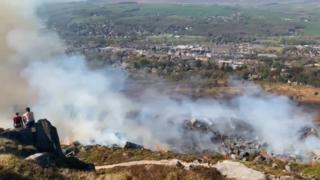Bradford Council’s mismanagement of Ilkley Moor has killed more grouse in a single day than a season of grouse-shooting. That’s the accusation levelled at the council by local shooters and gamekeepers, as wildfire rips across the moor at the height of the bird breeding season.
On day one, Easter Saturday, firefighters left two fires burn into the night after calling off their operation to tackle the blaze, now thought to cover more than 100 acres. Already, questions are being asked about the council’s management of the moor, and how that could have contributed to the fire.

In 2018, Bradford Council ended grouse-shooting on land it owns above the village of Ilkley, West Yorkshire. Councillors wanted to strike a blow against grouse shooters. However, they also ended gamekeeping on the moor, which includes fire prevention such as muirburn. ‘Controlled burning’ or muirburn creates firebreaks and encourages the regeneration of heather.
Thanks to Bradford’s politically-motivated ban, thousands of chicks of groundnesting birds have been burned alive in their nests, including ring ouzel and curlew, as well as grouse.
Duncan Thomas from shooting and conservation group BASC says: “Following the catastrophic decision of Bradford City Council we appear to be viewing scenes that the Gamekeeping Community predicted on Ilkley Moor. At the risk of ‘we told you so’ the objective is to put the fire out and support all who are grafting as we read this.
“The fire appears to have been started right on the urban edge amongst campers – so much for eco-tourism – and a further additional fire on an adjacent managed Moor has been extinguished as it hit a pre-burned [by gamekeepers, prior to the ban] firebreak.”
In a legal letter dated 26 May 2020, more than a year after we published this story, City of Bradford assistant solicitor Michael Bowness responds: ‘The claims in your article that the wildfire which occurred on Ilkley Moor last year was caused by the council failing to cut firebreaks and not renew the keepering licence (sic) are inaccurate. The fire occurred on the front steep scarp-slope of the moor, which is far removed from any area where cutting firebreaks would be considered reasonable and in part of the moor far removed from the agreed shooting licence coverage. The fire was a result of arson, the perpetrator having been apprehended by council officers, and subsequently arrested, charged and jailed for the offence. Further, a wildfire also occurred on the same day on a neighbouring, keepered moor and the recent devastating wildfire close to Widdop Reservoir was also on [a] keepered grouse moor. These incidents demonstrate that no moorland is safe or immune from wildfire whether keepered or not.’
More on the Bradford legal letter story here








